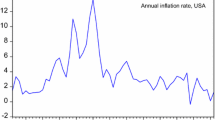Abstract
In this paper the authors analyze the forecasting ability of the term structure with respect to future inflation in Germany. In contrast to previous studies, they find evidence in favor of a nonstationary term premium. Assuming that the nonstationary part of the term premium can be approximated by an observable factor, they derive testable restrictions which cannot be rejected for German data. In an out-of-sample forecasting experiment, the model out-performs rival models which assume a constant term premium. Nevertheless, the authors find that the forecasting ability of the term structure is limited while the real interest rate, is revealed as a good predictor for future inflation rates. JEL no. E31, E37, E43.
Similar content being viewed by others
References
Baltensperger, E. (1998). Geldpolitik bei wachsender Integration (1979–1996). In Deutsche Bundesbank,Fünfzig Jahre Deutsche Mark. München: C. H. Beck.
Carstensen, K. (2001). Interpreting Cointegration in a Model of the Term Structure with Nonstationary Term Premia. Working Paper 153/01. Institut für Statistik und Ökonometrie, Christian-Albrechts-Universität zu Kiel. Kiel.
Duisenberg, W. F. (1999). Die einheitliche europäische Geldpolitik. http://www.ecb.int/key/sp990209.htm.
Evans, M. D. D., and K. K. Lewis (1994). Do Stationary Risk Premia Explain it All? Evidence from the Term Structure.Journal of Monetary Economics 33 (2): 285–318.
Hall, A. D., H. M. Anderson, and C. W. J. Granger (1992). A Cointegration Analysis of Treasury Bill Yields.Review of Economics and Statistics 74 (1): 116–126.
Hallman, J. J., R. D. Porter, and D. H. Small (1991). Is the Price Level Tied to The M2 Monetary Aggregate in the Long Run?American Economic Review 81 (4): 841–858.
Hamilton, J. D. (1994).Time Series Analysis. Princeton: Princeton University Press.
Hansen, G. (2001). Prognostiziert die Zinsstruktur die Inflation in Deutschland?Kredit und Kapital 34 (4): 554–578.
Hansen, G., J.-R. Kim, and S. Mittnik (1998). Testing Cointegrating Coefficients in Vector Autoregressive Error Correction Models.Economics Letters 58 (1): 1–5.
Jochum, C., and G. Kirchgässner (1999). Hat die Zinsstruktur Aussagekraft, für die zukünftige Inflation in Deutschland?, Eine Kritik des Mishkin-Ansatzes.Kredit und Kapital 32 (4): 493–519.
Johansen, S. (1988). Statistical Analysis of Cointegration Vectors.Journal of Economic Dynamics and Control 12 (2–3): 231–254.
Knez, P. J., R. Litterman., and J. Scheinkman (1994). Explorations into Factors Explaining Money Market Returns.Journal of Finance 49 (5): 1861–1882.
Lucas, A. (1995a). Unit Root Tests Based on M Estimators.Econometric Theory 11 (2): 331–346.
Lucas, A. (1995b). An Outlier Robust Unit Root Test with an Application to the Extended Nelson-Plosser Data.Journal of Econometrics 66 (1/2): 153–173.
MacKinnon, J. G., A. A. Haug, and L. Michelis (1999). Numerical Distribution Functions of Likelihood Ratio Tests for Cointegration.Journal of Applied Econometrics 14, (5): 563–577.
Mishkin, F. S. (1988). The Information in the Term Structure: Some Further Results.Journal of Applied Econometrics 3 (4): 307–314.
Mishkin, F. S. (1990a). What Does the Term Structure Tell Us about Future Inflation?Journal of Monetary Economics 25 (1): 77–95.
Mishkin, F. S. (1990b). The Information in the Longer Maturity Term Structure about Future Inflation.Quarterly Journal of Economics 105 (3): 815–828.
Seo, B. (1999). Distribution Theory for Unit Root Tests with Conditional Heteroskedasticity.Journal of Econometrics 91 (1): 113–144.
Shea, G. S. (1992). Benchmarking the Expectations Hypothesis of the Interest-Rate Term Structure: An Analysis of Cointegration Vectors.Journal of Business & Economic Statistics 10 (3): 347–366.
Tzavalis, E., and M. R. Wickens (1996). Forecasting Inflation from the Term Structure.Journal of Empirical Finance 3 (1): 103–122.
Wolters, J. (1995). On the Term Structure of Interest Rates: Empirical Results for Germany.Statistical Papers 36 (3): 193–214.
Wolters, J. (1998). Untersuchung der Renditestruktur am deutschen Kapital-markt 1970–1996. In E. Baltensperger (ed.),Spekulation, Preisbildung und Volatilität auf Finanz- und Devisenmärkten. Berlin: Duncker & Humblot.
Zhang, H. (1993). Treasury Yield Curves and Cointegration.Applied Economics 25 (3): 361–367.
Author information
Authors and Affiliations
Corresponding author
About this article
Cite this article
Carstensen, K., Hawellek, J. Forecasting inflation from the term structure. Rev. World Econ. 139, 306–323 (2003). https://doi.org/10.1007/BF02659747
Issue Date:
DOI: https://doi.org/10.1007/BF02659747




